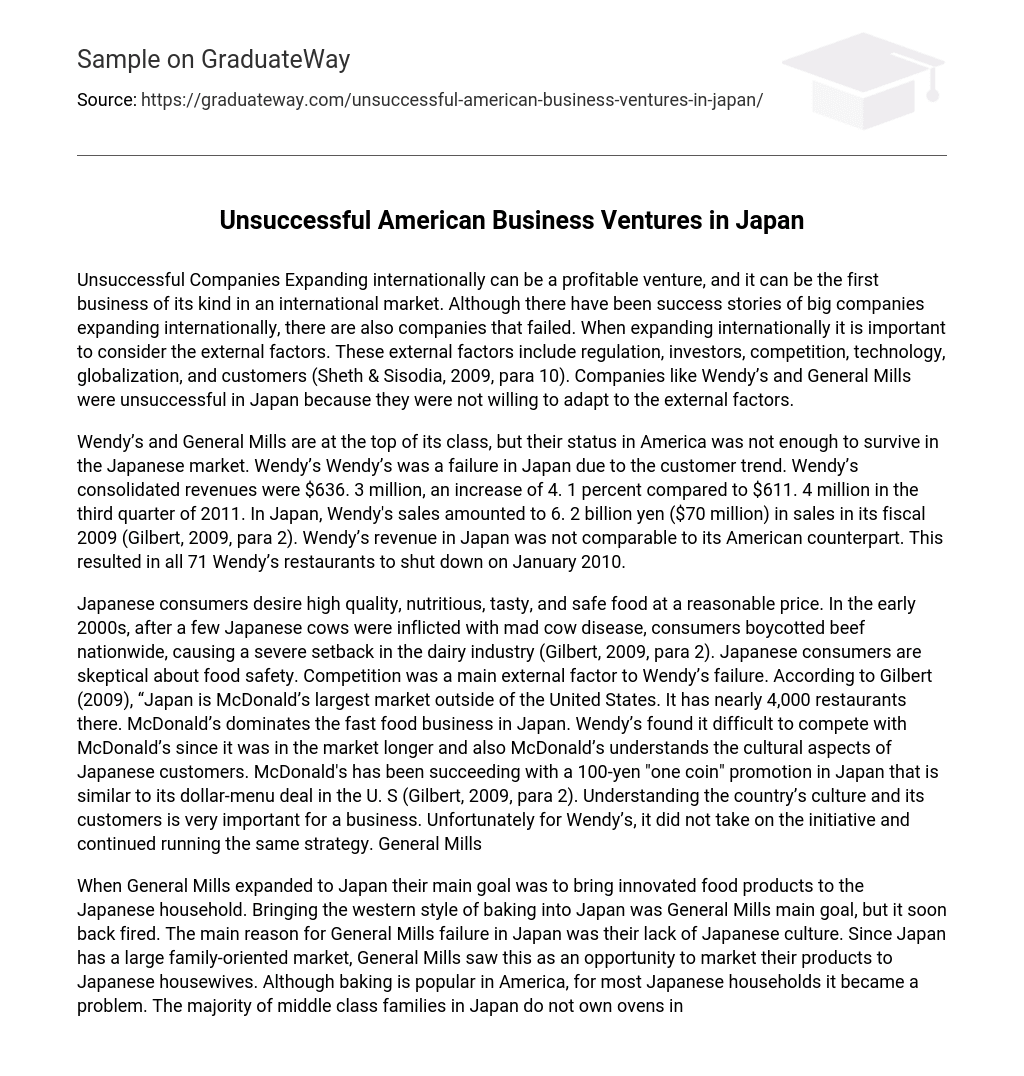Unsuccessful Companies Expanding internationally can be a profitable venture, and it can be the first business of its kind in an international market. Although there have been success stories of big companies expanding internationally, there are also companies that failed. When expanding internationally it is important to consider the external factors. These external factors include regulation, investors, competition, technology, globalization, and customers (Sheth & Sisodia, 2009, para 10). Companies like Wendy’s and General Mills were unsuccessful in Japan because they were not willing to adapt to the external factors.
Wendy’s and General Mills are at the top of its class, but their status in America was not enough to survive in the Japanese market. Wendy’s Wendy’s was a failure in Japan due to the customer trend. Wendy’s consolidated revenues were $636. 3 million, an increase of 4. 1 percent compared to $611. 4 million in the third quarter of 2011. In Japan, Wendy’s sales amounted to 6. 2 billion yen ($70 million) in sales in its fiscal 2009 (Gilbert, 2009, para 2). Wendy’s revenue in Japan was not comparable to its American counterpart. This resulted in all 71 Wendy’s restaurants to shut down on January 2010.
Japanese consumers desire high quality, nutritious, tasty, and safe food at a reasonable price. In the early 2000s, after a few Japanese cows were inflicted with mad cow disease, consumers boycotted beef nationwide, causing a severe setback in the dairy industry (Gilbert, 2009, para 2). Japanese consumers are skeptical about food safety. Competition was a main external factor to Wendy’s failure. According to Gilbert (2009), “Japan is McDonald’s largest market outside of the United States. It has nearly 4,000 restaurants there. McDonald’s dominates the fast food business in Japan. Wendy’s found it difficult to compete with McDonald’s since it was in the market longer and also McDonald’s understands the cultural aspects of Japanese customers. McDonald’s has been succeeding with a 100-yen “one coin” promotion in Japan that is similar to its dollar-menu deal in the U. S (Gilbert, 2009, para 2). Understanding the country’s culture and its customers is very important for a business. Unfortunately for Wendy’s, it did not take on the initiative and continued running the same strategy. General Mills
When General Mills expanded to Japan their main goal was to bring innovated food products to the Japanese household. Bringing the western style of baking into Japan was General Mills main goal, but it soon back fired. The main reason for General Mills failure in Japan was their lack of Japanese culture. Since Japan has a large family-oriented market, General Mills saw this as an opportunity to market their products to Japanese housewives. Although baking is popular in America, for most Japanese households it became a problem. The majority of middle class families in Japan do not own ovens in their homes (Knight, 1995, p. 09). General Mill’s solution to this problem was to create an all-in-one rice cooker with baking capabilities. General Mill’s all-in-one rice cooker launched with the name Cakeron. The new product was not getting repeat sales for two reasons: rice is eaten in Japan with every meal, and rice is also considered sacred. Since rice is a sacred dish in Japan and it is not common to use a rice cooker to bake cakes. This method of baking a cake in a rice cooker is considered a cultural problem for most Japanese housewives (Knight, 1995, p. 10).
This lead to the downfall of the product and eventually the downfall of a General Mill’s in Japan. Merrill Lynch & Co. Merrill Lynch & Co. , one of the largest financial management and advisory company in America, was unsuccessful in Japan due to its lack of investors. Merrill Lynch saw big potential in Japan’s households. According an article in The Wall Street Journal, “The lure of Japan’s household assets — $11. 7 trillion today, half of that in cash and deposits — was irresistible” (para 8). In 1998, Merrill Lynch & Co. ired a team of 2,000 people and took over 33 offices. Their goal was to introduce the western style of investing in finance to the Japanese market. Although Merrill Lynch & Co. produced a large network in Japan, it was not enough to attract investors. By the early 1990s, the client base dwindled to about five or six customers per broker (Singer, 2001, para ). The lack of investors was a main reason for the company’s unsuccessful venture. When Merrill’s clients were dwindling away their solution was to launch several advertising campaigns.
Tens of millions of dollars were spent on TV advertising campaigns that missed the mark (Sing, 2001, para ). The company over invested in its advertising campaign and still it lacked awareness to the Japanese consumers. According to Singer, “Merrill piled up client assets, reaching 1. 7 trillion yen ($13. 7 billion) in client money under management by June of 2001 — but that was still shy of the roughly 2. 3 trillion yen needed to break even” (para ). After the substantial loss Merrill Lynch & Co. was shut down after a slow run. Conclusion
When entering a new market, a company should choose how to approach it and to which degree it must adapt their strategy to the local conditions. Unfortunately for General Mills, Wendy’s, and Merrill Lynch & Co. they failed to adapt to Japan’s culture and changing external factors. Wendy’s entered a new market that was dominated by their competition. General Mill’s introduced a brand new product to Japan while ignoring the cultural norms of the national dish. A company that continues to practice the same type of strategy when the external factors change then it is bound to fail.





